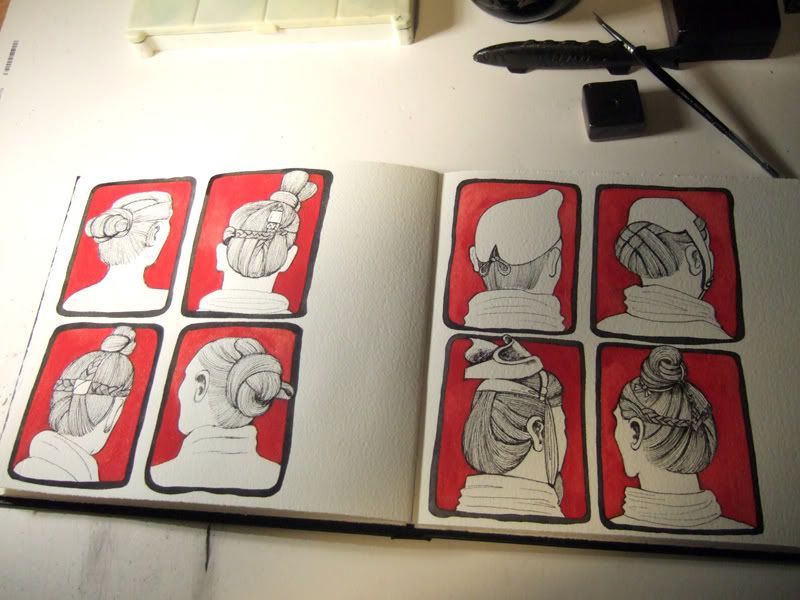
I've been reading the catalogue of The First Emperor exhibition which we visited last weekend. While at the exhibition I was fascinated by the beautifully detailed sculpted hairstyles of the terracotta warriors and wanted to know more about how they were made. It seems that the heads were made in moulds (a bit like chocolate Easter eggs) and then customised with hair styles and hats. The whole terracotta warrior making process was a well organised production line, with teams of workers specialising in just one stage – the person who 'did' braided hair must have been a real perfectionist! I would have loved to spend a few days in the exhibition with my sketch book and a comfy seat, but sadly that wasn't possible, I had to be content with the photos in the catalogue as reference for my sketchbook studies of the warriors' braided hairstyles.
A Chinese pottery production line was the subject of a recent Radio 4 programme in which the artist and 'Spitting Image' satirist and now potter, Roger Law spent time working in Jingdezhen – the porcelain capital of China. He explained that each stage of the process of making a beautiful pot was carried out by a family run workshop who had specialised in that stage of the production process for generations – so if one of the links in the chain were to disappear, the skills learnt over generations would be lost forever.






oh that is so interesting. You know, it again brings to mind some of the skills that have been lost by being broken in 'current' generations. I think of watch makers or clock makers, some of the masons who used to make all those lovely embellishments on the old buildings and cathedrals, for instance.
ReplyDeleteDiane
Alberta Postcards
Diane's Flickr photos
I agree, the people who did the hair must have had SO much patience. Also the people who did the soles of the shoes, the ones on the kneeling warriors, all those hobnails, perfectly formed, for one or two people to see.
ReplyDeleteSuch a wonderful exhibition, marvellous to be so close to the warriors. I think it unlikely that I will ever visit the tomb in Chin
Joanna
Another lovely informative post, Celia. And what did my eye spy? Your brush rest! Is it a soapstone carving? A chopstick rest?
ReplyDeleteYour sketchbook studies are treasures in themselves.
(Too wet to do anything I'm going to get out my book about early dynasties.)
This is so interesting.
ReplyDeleteI came across an exhibition on roman hairstyles whilst on holiday in Italy and again - for the women there were very different braids at different times of roman history.
Your sketchbook studies are wonderful, as I am sure was the exhibition. Were the horses interesting too? That's what attracts me.
ReplyDeleteOn the skills debate, I think perhaps more people are recognising the worth of and taking up "old " crafts again.And the internet has brought to our attention the quality and variety of such things, so perhaps we might look forward with some hope?
Thanks for this. You are making me itch to see the exhibition.
ReplyDeleteMy first visit to your blog, very enjoyable. I love your chickens!
ReplyDeleteFrances at Faire Garden
Diane - there are a few people keeping old traditions alive, but I agree - there was so much skill in the hands-on crafts.
ReplyDeleteJoanna - the details are amazing.
Dinahmow - you are observant! My brush rest is a cast iron fish brush rest which I bought from a calligraphy shop in Nara, Japan. It is very heavy, so doubles as a paper-weight to stop the scroll of paper rolling up. Clever or what!!!!
GBVC - the Roman hairstyles exhibition sounds fascinating.
Threadspider - the horses were beautiful. I hope the crafts people who learnt as apprentices when they were young now teach their skills to others. So many "tricks of the trade" were never written down.
CS - not much time left to see it!
Frances - welcome to my corner of Suffolk! And another admirer of my girls - they like to make people happy!
The reason that they have such intricately managed hair is because the ancient Chinese (of both genders) had a lot of hair. People didn't usually cut their hair, because damaging any part of your body was considered an affront to your parents.
ReplyDelete